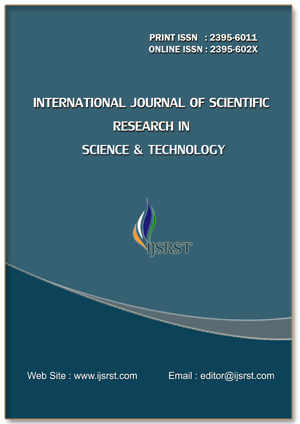Bioaccumulation of Zinc, Characterization and Quantitative Estimation of Zinc Binding Proteins in Saccharomyces Cerevisiae
Keywords:
Zinc, Saccharomyces cerevisiae, Bioaccumulation, SDS-PAGEAbstract
The discharge of industrial waste containing heavy metals and synthetic compounds into the environment causes significant environmental and health risks. Heavy metals can bind to metal binding sites on plasma membranes of the cells in living organisms. These binding sites are often specific for essential metals like zinc, iron, copper and calcium.The heavy metals may have a higher affinity for these binding sites compared to essential metals, leading to their displacement. By occupying metal binding sites, heavy metals can inhibit the normal functions of essential metals.They may interfere with the transport of ions across cell membranes, affecting critical cellular processes. This interference can disrupt enzymatic activities, as many enzymes require specific metal cofactors for their proper functioning. The substitution of essential metals by toxic heavy metals can lead to enzyme inactivation. The bioaccumulation of heavy metals in yeast species, particularly Saccharomyces cerevisiae, has gathered considerable attention. S.cerevisiae is an ideal model organism to identify the mechanism of biosorption. S.cerevisiae is a unicellular eukaryotic organism that shares many essential features with higher eukaryotes. Yeast was cultured in the presence of varying concentrations of Zn2+ (5, 10, 20, 50 and 100µg/ml).The accumulated zinc by S.cerevisiae was measured and correlated with changes in protein content. A decrease in protein content was observed when the concentration of Zn2+ exceeded 20µg/ml. Proteins extracted from yeast cells exposed to different concentrations of Zn2+ were separated using Sodium Dodecyl Sulfate Polyacrylamide Gel Electrophoresis. SDS-PAGE allows for the separation of proteins based on their molecular weight.The molecular weight of individual proteins was estimated by comparing their migration patterns on the SDS-PAGE gel to molecular weight markers.The study aims to characterize Zn2+ binding proteins in S.cerevisiae by analyzing the protein profiles under different zinc concentrations. Proteins that show changes in abundance or migration patterns in response to zinc concentrations may be postulant for Zn2+ binding proteins.The decrease in protein content with higher zinc concentrations suggests a potential negative impact of excess zinc on cellular protein synthesis or stability. Identification and characterization of Zn2+ binding proteins can provide insights into the cellular response to zinc stress and contribute to our understanding of metal homeostasis in yeast.
References
- Passow H., Rothstein A. and Clarkson T.W., Pharmac. Rev., 1961, 13, 185-224.
- Volesky B., In: Volesky B. (Ed.), Florida: CRC Press, 1990a, 3-5.
- Bishop P.L., Beijing: Tsinghua University Press, 2002.
- Bury et al., J. of Expt. Biol., 2004, 206(1), 11, 1-18.
- Daniels M.J., Turner Cavet J.S. et al., J. Biol. Chem., 1998, 273, 22957-961.
- Diazcruz M.S., Mendieta J., Monjonell A. et al., J. Inorg. Biochem., 1998, 70, 91-98.
- Jiang L.J., Maret W. and Vallee B.L., Proc. Natl. Acad. Sci.USA, 1998, 95, 9146-149.
- Chou A.Y., Archdeacon J. et al., Proc. Natl. Acad. Sci.USA, 1998, 95, 5293-298.
- Cruz C.C.V., da Costa A.C.A. et al., Biomass Bioresour. Technol., 2004, 91, 249-57.
- Qdais S., Desalination, 2004, 164(2), 105-110.
- Fischer R., Siedel H, Morgenstern P et al., Eng. Life Sci., 2005, 5(2), 163-168.
- Banfalvi G., Chemosphere, 2006, 63(7), 1231-1234.
- Volesky B., In: Volesky B. (Ed.), Biosorbents and Biosorption of heavy metals, CRC Press, Boca Raton, Florida, 1990,221-238.
- Khoo K.M. and Ting Y.P., Biochem Eng. J., 2001, 8, 51-59.
- Inouhe M., Sumiyoshi M. et al., Plant Cell Physiol., 1996, 37(3), 341-46.
- Strandberg G.W., Shumates S.E. II et al., Appl. and Environ. Microbiol., 1981, 41(1), 237-45.
- Brady D. and Duncan J.R., Enzyme Microb.Technol., 1994a,16, 633-8.
- Gray W.D., The Relation of Fungi To Human Affairs, XIII+510 pp, Henry Holt and Co., New York, 1959.
- Huang C.P., Huang C.P. and Mbrehart A.L., Water Res., 1990, 24, 433-439.
- Vijver M.G., Gestel C.A.M.V. et al., Environ. Sci. Technol., 2004, 38, 4705-12.
- Macdiarmid C.W. and Gardner R.C., J. Biol. Chem., 1998, 273, 1727-732.
- Smith R.L. and Maguire M.E., J. Bacteriol., 1995, 177, 1639-640.
- Snavely M.D., Florer J.B., Miller C.G. et al., J. Bacteriol., 1989, 171, 4752-760.
- Snavely M.D., Florer J.B., Miller C.G. et al., J. Bacteriol., 1989, 171, 4761-766.
- Paulsen I.T., Sliwinski M.K., Nelissen B. et al., FEBS Lett., 1998, 430, 116-125.
- Brierley C.L., J. Geomicrobiol., 1990, 8, 201-223.
- Baker A. J. M. and Brooks R. R., Biorecovery, 1989, 1, 81-126.
- Verma R.S., Rao T.V.G. and Prasad R., Biochem. Biophys. Acta, 1984, 778, 289-97.
- Wen-Xiong, Wang and Philip S., Ecotoxicol. and Environ. Safe., 2005, 61(2), 145-59.
- Lowry O.H., Rosebrough N. J., Farr A.L. et al., J. Biol. chem., 1951, 193, 265-75.
- Shapiro A.L., Vinuela E. and Maizel J.V., Biochem. Biophys. Res. Commun., 1967, 28, 815.
- Jernigan R., Raghunathan G. and Bahar I., Curr. Opin. Struct. Biol., 1994, 4, 256.
- Dudev T. and Lim C., J. Chin. Chem. Soc., 2003, 50, 1093-102.
Downloads
Published
Issue
Section
License
Copyright (c) IJSRST

This work is licensed under a Creative Commons Attribution 4.0 International License.

